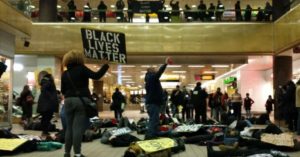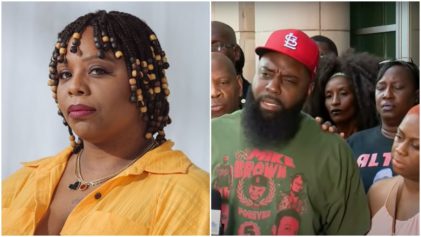
On the six month anniversary of Mike Brown’s death, protesters staged a four-minute die-in at Grand Central Station in New York City on Monday, February 9, 2015 (Photo: @KeeganNYC/Twitter)
In New York City, plainclothes NYPD and Metropolitan Transit Authority police officers spied on #BlackLivesMatter protesters who participated in die-ins at Grand Central Terminal, the New York Daily News has reported.
Documents obtained by The Intercept reveal that the surveillance involved live updates from the police on the number of protesters and their location during the over 30 protests that took place between November 2014 and February 2015. Photos of individual activists were taken as well.
The surveillance effort against #BlackLivesMatter was made possible through a joint effort of MTA counterterrorism agents. undercover police and NYPD intelligence officers.
“We accommodate peaceful protest in our transportation system, while also ensuring that protest activities do not prevent customers from using the system for transportation,” MTA spokesman Adam Lisberg told the Daily News. “We take all appropriate police measures to ensure the safety and security of our customers, but we do not discuss the particulars of those operations.”
“If anybody thinks that we would have hundreds of protesters in one of the busiest locations in the City of New York at the height of rush hour, and we wouldn’t keep an eye on them, they have rocks in their head,” an MTA source said.
The NYPD and MTA spying effort, which reportedly fell short of infiltration, raises the question as to why the police are keeping tabs on peaceful Black protesters who are exercising their First Amendment right to free speech. It also has made many activists wonder what comes next, as the movement to protest the killing of Black people by law enforcement grows. Activists are concerned and believe the police are overreacting.
“It just makes me feel like I can’t practice my civil rights without feeling like somebody is going to be watching me,” Jose LaSalle, 46, founder of the watchdog group, Copwatch Patrol Unit, told the Daily News.
LaSalle was not surprised, but still upset that his name and photo appeared in the documents. “If you have a voice and use your voice, they think you might be a problem.”
The information comes a month after reports that the Department of Homeland Security has regularly monitored the #BlackLivesMatter movement since protests began in Ferguson, Mo. a year ago. In July 2015, George Joseph reported in The Intercept that documents released by DHS “indicate that the department frequently collects information, including location data, on Black Lives Matter activities from public social media accounts, including on Facebook, Twitter, and Vine, even for events expected to be peaceful. The reports confirm social media surveillance of the protest movement and ostensibly related events in the cities of Ferguson, Baltimore, Washington, DC, and New York.”
Joseph added, “They also show the department watching over gatherings that seem benign and even mundane. For example, DHS circulated information on a nationwide series of silent vigils and a DHS-funded agency planned to monitor a funk music parade and a walk to end breast cancer in the nation’s capital.”
DHS had planned surveillance operations in a number of historically Black communities, and following the death of Freddie Gray in Baltimore, DHS Federal Protective Service placed 400 officers on duty, and integrated their police into the Governor of Maryland’s Operations Center and the Mayor’s Emergency Operations Center.
Nusrat Choudhury, a staff attorney at the American Civil Liberties Union’s Racial Justice Program, told Mother Jones that while such surveillance may not break the law, it could have chilling effects on people’s constitutional rights.
“There’s no question at all that the kind of mapping identified by the documents provided to Intercept chills people’s First Amendment-protected activities,” she said. “Of course it makes people feel afraid to go to these kinds of protests because of the impact it might have in terms of law enforcement’s ability to gather intelligence about them.”
Raven Rakia, a journalist who specializes in policing and state surveillance, told The Intercept that the move by DHS to spy on the Black protest group is not a surprise, given the long history of federal government spying and clamping down on the Black Panther Party and other Black social movements and organizations.
“There’s a long history of the federal agencies, especially the FBI, seeing Black resistance organizations as a threat to national security,” Rakia said.
As these recent examples of government surveillance could have a chilling effect on Black social protests, the Black community is reminded of J. Edgar Hoover’s COINTELPRO program, which the FBI chief created to monitor, infiltrate and destroy civil rights organizations and “prevent the rise of a messiah who could unify, and electrify, the militant black nationalist movement.” Hooever called the Black Panther Party “the most dangerous threat to the internal security of the country.”
And now, some people may ask whether history is repeating itself.


